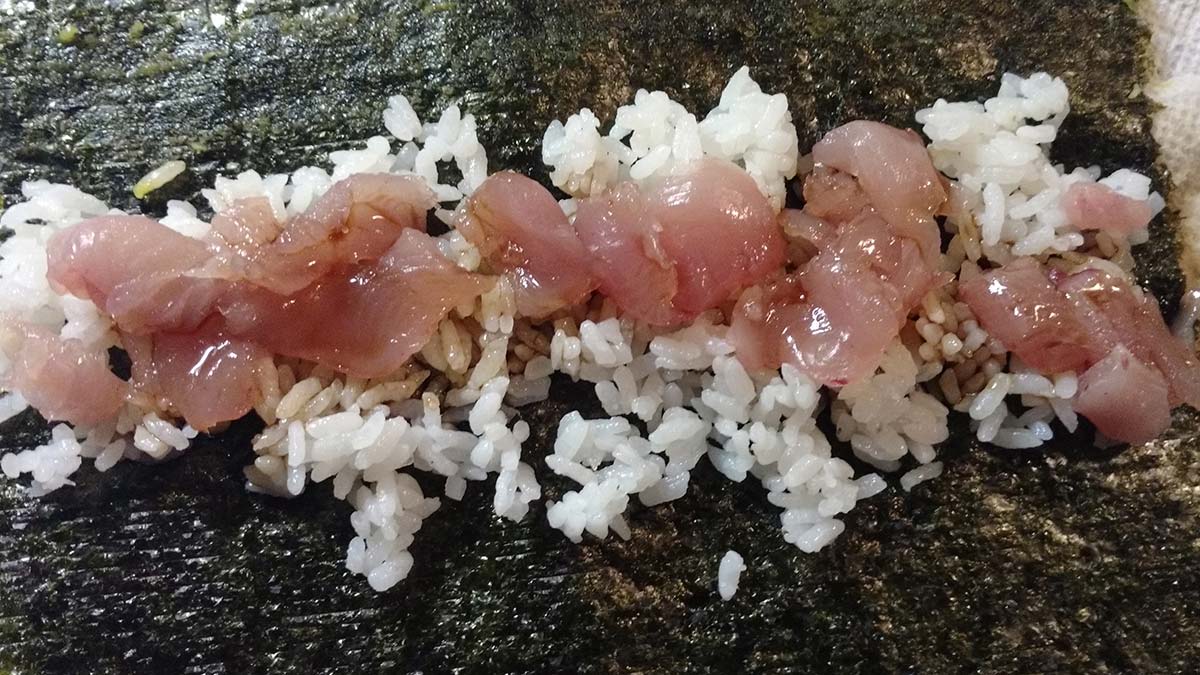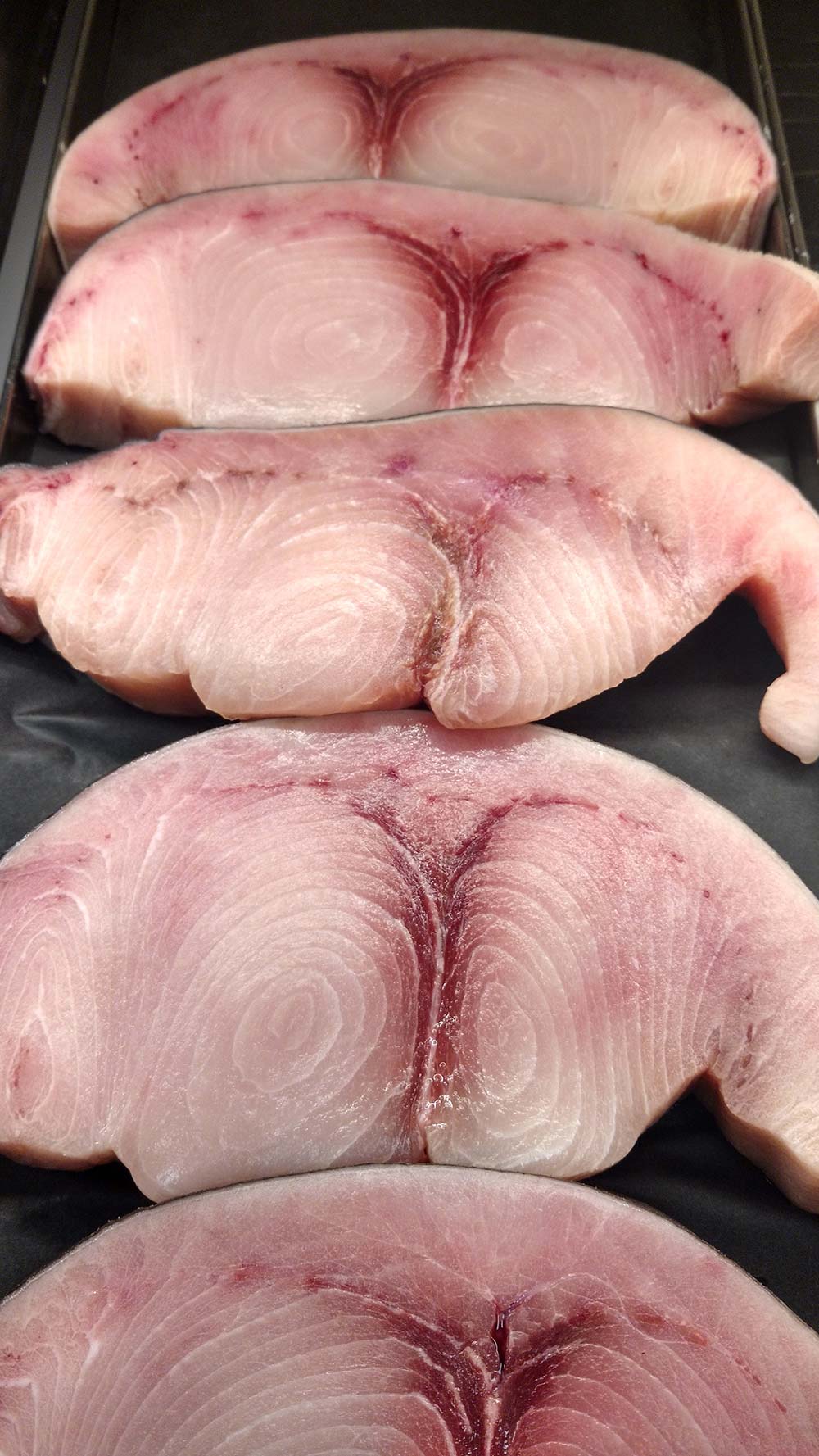
Learning to select fish at the market prevents paying good money for a bad product.
Some of our major holidays have just come and gone, but fishing season still seems decades away. With the demise of the winter flounder, tomcod, and river herring populations there aren’t many inshore saltwater fishing opportunities until the schoolie stripers return in spring. Meanwhile, your frozen stash of last season’s catch is probably depleted or marginally palatable. So, your best option for a taste of fresh seafood is to visit a local fish market.
While it may be hurtful—to both your pride and your wallet—to pay for seafood, at least you have a chance to cook and eat a few species that you couldn’t catch in our nearshore waters. Salmon, swordfish, trout, catfish, shrimp, scallops, halibut, cod, haddock, tuna, tilapia, and several others are readily available, tasty, and can be prepared in a variety of ways. The main concern, however, is quality. Determining the freshness of fish is easy—if you know how to look.
Learning To Look: Whole Fish
Of course, you can purchase fish whole, filleted, or steaked. And there are different methods of checking the quality of fish depending on their form. Let’s start with whole, gutted fish.
First, look at the eyes. The eyes of a fresh fish are full, convex, and shiny. As dead fish age their eyes become cloudy, dry, and sunken. The more concave and gray the eyes, the longer the fish has been on ice.
Second, peek at the gills. A fresh fish has bright, blood-red gills. As a finfish deteriorates, the gill color fades from red to burgundy to maroon to off-purple to purple-gray and finally to all gray. A specimen with graying gills is only good for crab bait.

Third, inspect the skin. The skin and scales of a recently-caught fish are bright, shiny, and colorful. A fish that’s been on ice over a week develops a flat, grayish look and loses the vibrant, distinguishing markings of the species. For example, a whole porgy, left over time in the market, loses its silvery “hot pink” color, and fades to flat silvery-gray, and finally just to light gray.
Fourth, smell the fish—this is a reliable indicator. You know what a whole, old fish smells like—it smells like crab bait or cat food. Pick it up and sniff it. Smell the gut cavity and gill area. If it’s repugnant, the flesh may still be “safe” to eat cooked but it’s too old for a quality meal.
Other ways to determine the freshness of whole fish include pulling on the scales—they should adhere firmly—and pressing on the flesh with a finger. It should rebound. If the flesh is mushy and your fingertip impression remains, then the lack of resiliency is due to deterioration.
Learning To Look: Fillets
Some of the same methods of checking the quality of whole fish apply to fillets. Again, pick up a fillet (the fish-market attendant should willingly place it on a piece of paper and hand it to you), and sniff it. This time, however, you aren’t trying to detect a rotten smell because there is no gut or gill cavity. Rather, an aged fillet will be “fishy” and have an ammonia-like odor, which is a byproduct of the deterioration and decomposition process. Even after a fillet is cooked—such as in a restaurant—old fish, although not harmful to eat, will have a slight ammonia taste and smell, which is typical of aged cod. Fresh fish should only offer a briny aroma of the sea.
¼ cup white wine
½ teaspoon chopped parsley
2 tablespoons lemon juice
1/8 teaspoon pepper
2 bay leaves
½ teaspoon minced garlic
1 ½ cups chicken broth
1 pat of butter (a teaspoon to a tablespoon)In a large skillet, mix everything except fish. Bring to a boil. Reduce heat and slowly add fish. Simmer, covered, for about 8 to 10 minutes, depending on thickness, or until fish flakes easily. Remove fish with a slotted spatula. Do not overcook.
Look for clarity in a fillet. From your position in front of a display case, this is the easiest and quickest way to tell the quality of a fillet. Regardless of color, i.e., whether a “white” cod fillet, an “orange” salmon fillet, or a “red” tuna steak, the flesh should have a translucent appearance. If the fillet looks whiter, cloudier, or opaquer than it should, it’s old.
Deteriorating flesh won’t appear firm and solid; rather, it will look cratered, separating, or disintegrating. Again, the protein has lost its resilience and is aged over a week.
Steaked fish, as is common with salmon, swordfish, and halibut, provides a unique cross-section examination of the product. An old salmon steak will show graying or browning (rather than orange/white) around the abdominal cavity and along the normally dark red meat located between the orange fillet and the skin. Old red-meat sections in a swordfish steak turn from dark red to brown.
Another tip when buying from a fish market is to ask for the fillets displayed closest to you, meaning closest to the glass. Older fish are usually nearer the attendant so those will be grabbed and sold first. That’s how markets rotate their stock.
Learning To Look: Shellfish

Be especially cautious when choosing shellfish and crustaceans. Unlike old finfish, bad ones can easily cause food poisoning. For starts, always avoid shellfish that are open—those are dead. But if they’re only slightly open they may still be alive. Tap on the shell to find out—it should snap shut. Ask the counter person only for those with closed shells.
Don’t buy pre-cooked lobsters. They may look easy and inviting sitting there on ice; however, those died one night in the lobster tank, and were then retrieved, cooked, and displayed for sale to avoid financial loss. Previously dead lobsters are usually safe to eat. But they aren’t fresh, are deceptively marketed, and have mushy tail flesh.
Because shrimp are from distant, warm waters and spoil fast they’re normally shipped frozen and then thawed on-site for display. It’s probably safest to purchase them still frozen in a sealed, two-pound bag. Look for those that have been mechanically de-headed and sliced along the back, which are called “easy peel.” Freshly-thawed shrimp on display should be firm, translucent, and have no “off” odor. If you want to buy them loose and thawed, ask to smell a couple.
Scallops are safer to consume than whole shellfish (clams, oysters, mussels) because you only consume the muscle, not the bacteria-containing internal organs. They are categorized and sold as “bay” and “sea” scallops. Bay scallops are smaller and can sometimes be caught locally, such as in the Niantic River or Nantucket Harbor. But those sold in markets are usually from southern waters and shipped frozen to the Northeast. Sea scallops are larger, more expensive, and usually harvested in deep northern waters such as those off Block Island. Choose scallops as you would a fish fillet—they should appear somewhat translucent and have a briny, sweet smell. Like shrimp, you can also buy these bagged and frozen.
Cooking Your Chosen Seafood
1 medium onion
¼ lb. mushrooms
1 tablespoon minced garlic
1 ½ cups tomato puree
1 cup chicken broth
¾ pint of cherry tomatoes
½ tablespoon Italian seasoning blend spices
1 tablespoon capers
1 teaspoon salt
½ small yellow squash
1/3 cup sour creamChop onion and halve or quarter mushrooms, set aside. In large skillet, warm oil over medium-high heat until hot but NOT smoking. Add the onion and garlic and cook until mixture starts to brown, stirring often. Add the mushrooms, tomatoes, tomato puree, water, and spices and bring to a boil. Reduce heat to low, cover, and simmer for 15 minutes. Slice squash into half-moon shapes and cut sea scallops in half or quarters if large. Return tomato sauce mixture to a boil. Add squash, capers, and scallops and cook until almost done, about 5 minutes. Add sour cream and return to boil. Remove from heat and spoon over fettuccine or other broad noodles.
The next hurdle is cooking fish in an appealing way. Never buy seafood so far in advance or in such a large quantity that you must freeze it. Fish that’s been on ice for a while or previously frozen will become stronger tasting and mushy when thawed. Same-day purchases are best. Most fish markets have seafood delivered on Fridays, which makes it the best shopping day. Don’t be afraid to ask the fishmonger about delivery days.
If you intend to enjoy sushi or sashimi, it’s safest to purchase it at a quality Japanese restaurant or local supermarket where an employee is a dedicated, trained sushi chef, such as at The Fresh Market or Whole Foods Market, among others. If you must make your own sushi during the offseason, speak with the fish-market manager to inquire about “sushi quality” tuna or salmon; otherwise, you’re taking a great risk of becoming ill. Or just use mock crab, cooked shrimp, or smoked salmon, all of which are much safer.
To help rid any fishy oiliness or off flavor before cooking, marinate steaks or fillets for about a half-hour in equal, small amounts of white wine and lemon juice, flipping it occasionally. Skinning the fillets and trimming all dark meat (such as is found on a salmon or bluefish) before preparing greatly helps keep the fish mild. That’s because the skin and dark meat retain most of the fish oils, which permeate the flesh when cooked. This also reduces your PCBs and mercury intake, which are primarily stored in the fatty tissue.
The author is an adjunct professor at Southern Connecticut State University, where he teaches nutrition courses in Meal Management and Food Selection & Preparation.


